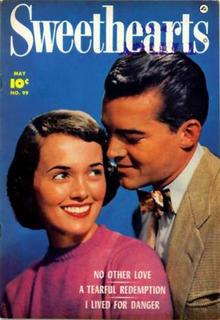 This blog is something of a continuing research project for me. What I'm going to do with this is unknown (a book? long article? a musical?), but the more that I look at the history of the genre, the more that things tend to not clear themselves up and instead become even murkier.
This blog is something of a continuing research project for me. What I'm going to do with this is unknown (a book? long article? a musical?), but the more that I look at the history of the genre, the more that things tend to not clear themselves up and instead become even murkier.Take television's relationship to comics, for example. I always assumed (and I think a lot of other people, as well) that the introduction of the TV into more American homes made comic circulation drop. Yet as the number of TVs increased (44,000 in the US in 1947, 2 million by 1949, and more than 23 million by 1953), comic circulation seemed to also surge (Walt Disney's Comics and Stories, the perennial leader, had a monthy total nearing 3 million in 1952, compared with just under 2 million six years earlier).
And I always assumed that television soap operas dragged the housewife (which was romance comics' earliest market) away from the printed page and instead placed her in front of that tiny little screen, causing the first major romance comics purge in the early 50s. Now I'm not so sure.
Soap operas of the 50s were nothing like those of today. The first soap operas were broadcast in 1951 ("Search for Tomorrow" and "Love of Life"), yet they were only 15 minutes long (and didn't expand to a half-hour until '56). I'm not sure if a couple of 15-minute television shows could have that much of an effect on house wives deciding on whether or not to buy a comic book.
Plus, throughout the 30s and 40s (and even well into the TV age), there were many radio soaps that outnumbered their TV counterparts. Why would they have been that much less of an issue, even though there were many more of them?
If you look at the incredibly informative list of romance comics that Dan Stevenson produced, you'll find that nearly 1/4 of all comic titles began and were cancelled before the first television soap opera even aired. Whole companies (like Fox) weren't around to challenge the soaps, and in some cases, other publishers (including Ajax-Farrel and Charlton) produced the majority, if not all, of their work in the post-TV era.
So what was it? Well, I think we've overestimated the number of housewives who bought and read romance comics in the first place. Yes, Young Romance sold extremely well. And yes, Atlas produced dozens of romance comics geared to the housewife in the late-40s that likely helped keep their company afloat. But by the early 50s, well before the TV soap had fully controlled the minds of American woman, it seems obvious to me that they had stopped reading romance comics at the rate at which they first did. Why do I say this? Look at the stories. Comic stories were less about married couples or even girls looking to marry and more about teenagers looking for that first love, first kiss.
Of the popular Simon/Kirby produced comics, which one had the fewest issues published (and never broke that bi-monthy schedule)? Young Brides. And one of the most successful romance comic of the early 50s (at least sales-wise) was Fawcett's Sweethearts, which featured stories mostly of the high-school and slightly older set.
I think we've overestimated the whole housewives thing. Yes, it was there. That is obvious. But its impact on the success of romance comicsmay have been on its earliest period and quickly faded away, replaced by teenage girls, who suddenly had a disposable income and a lot of free time.
Were comics' dominance squeezed out by TV? Probably. Was that the biggest issue? Maybe, although the anti-comics backlash of the mid-50s likely had a lot to do with it, if not more than TV. And what of TV's effect on the romance comic? I don't know, but it's becoming more obvious that it had a lot less to do with than many previously thought.
No comments:
Post a Comment